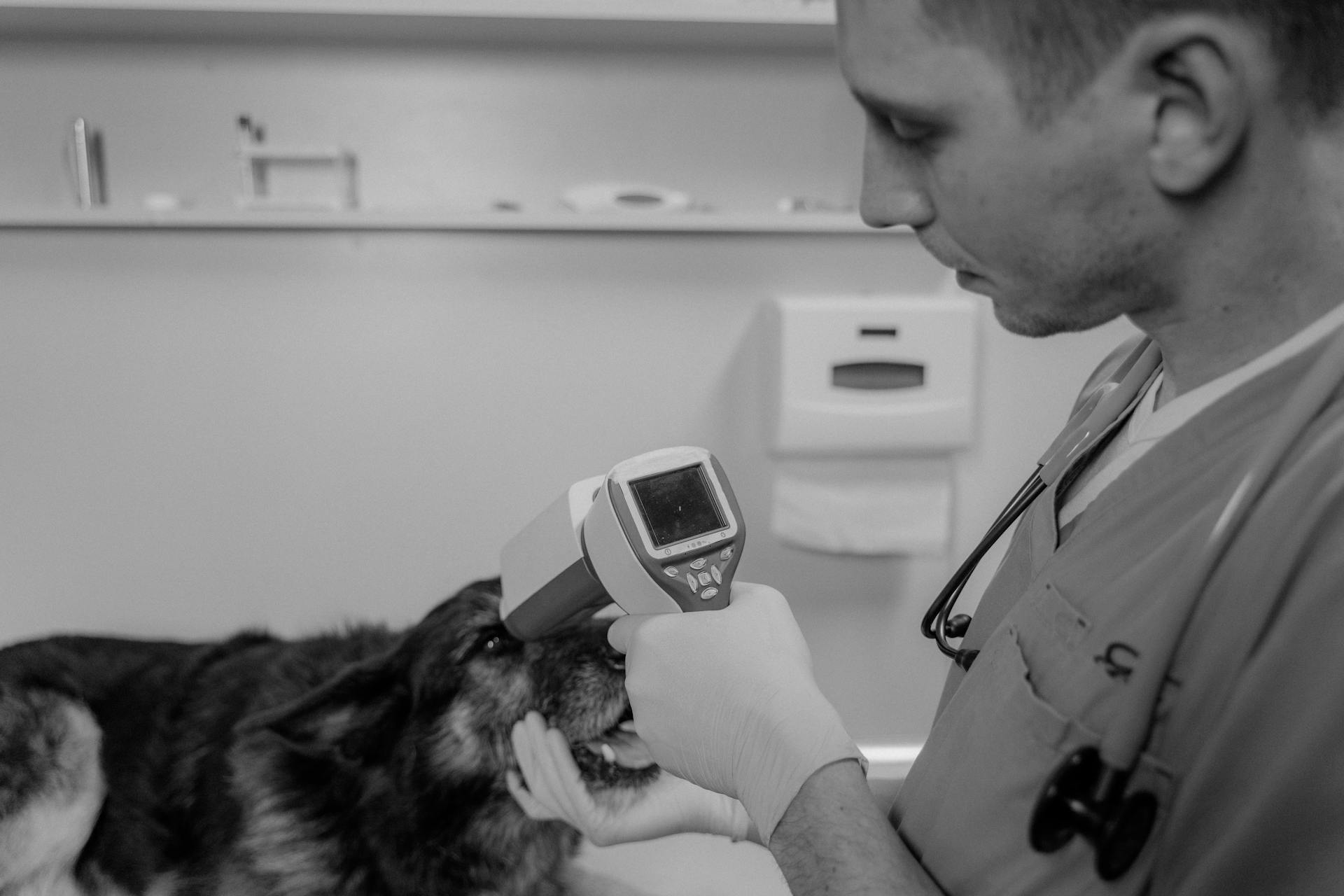
If your furry friend is experiencing vomiting, it's essential to find a suitable medication to alleviate their discomfort. Maropitant citrate, a medication commonly used to treat canine vomiting, works by blocking the action of a chemical called substance P, which is involved in the vomiting process.
Maropitant citate has a quick onset of action, often within 30 minutes of administration. This makes it a popular choice for treating acute vomiting episodes in dogs.
In some cases, metoclopramide may be prescribed off-label to help manage vomiting in dogs. This medication works by stimulating the movement of food through the digestive system and reducing the risk of vomiting.
What is Cerenia?
Cerenia is an FDA-approved medication for dogs that helps prevent and treat vomiting caused by motion sickness. It's also used to alleviate nausea associated with chemotherapy.
Maropitant, the active ingredient in Cerenia, is available in oral tablet formulation and as an injectable formulation for use in both dogs and cats. Veterinarians may prescribe the tablets for extra-label use to treat vomiting in dogs.
The tablets are approved for use in dogs, but not in cats, and are available under the brand name Cerenia and as generic maropitant. Your veterinarian will determine whether this medication is right for your dog.
Cerenia is also used to treat acute nausea and vomiting in dogs, and can be compounded into a specific formulation if your dog has trouble taking pills or is allergic to an ingredient in the FDA-approved medication.
How It Works
Cerenia specifically targets the part of the brain that triggers vomiting, making it a potent drug for treating and preventing vomiting from various causes.
The brain's emetic center is where the magic happens, and Cerenia works by preventing signals from being sent that would otherwise trigger nausea and vomiting.
Cerenia prevents nausea and vomiting by competitively antagonizing substance P, a neurotransmitter responsible for triggering these symptoms.
This means that Cerenia keeps your dog from feeling or getting sick, which is a huge relief for pet owners who've dealt with motion sickness or other causes of vomiting.
The vestibular system in the ear plays a role in collecting and processing information about balance and motion, and when it feels something different than the eyes see, nausea and vomiting can occur.
Cerenia prevents these signals from being sent, effectively blocking the vomiting response.
By targeting the brain's emetic center and blocking the neurotransmitter substance P, Cerenia is a highly effective medication for preventing and managing vomiting in dogs.
Directions
If you're giving your dog Cerenia to prevent motion sickness, make sure to administer it with a small amount of food at least two hours before traveling.
To give Cerenia correctly, follow the directions on the label or as advised by your veterinarian.
If your dog vomits while on Cerenia, contact your veterinarian right away.
If you miss a dose of Cerenia, speak with your veterinarian about what to do. They may advise you to give the dose when you remember, but if it's almost time for the next dose, they may instruct you to skip the missed dose and resume your normal schedule.
Discover more: Medications You Can Give a Dog
The dosage for Ondansetron varies depending on the condition being treated and whether it's given orally or injected.
Here are some general guidelines for Ondansetron dosages:
Cerenia tablets should be given by mouth, and the correct dosage depends on the reason for treatment.
Possible Side Effects and Risks
Dogs may experience uncommon side effects from Cerenia, including decreased energy level (lethargy), loss of appetite, diarrhea, incoordination, excessive drooling, vomiting or retching, and trembling.
Direct side effects from Cerenia in dogs are rare, but your veterinarian may want to reevaluate your pet if vomiting continues despite treatment.
In humans, Cerenia is not intended for use and can cause skin reactions, eye irritation, and other side effects if ingested or exposed to the skin.
Some possible side effects of Cerenia in dogs include:
- Decreased energy level (lethargy)
- Loss of appetite
- Diarrhea
- Incoordination
- Excessive drooling
- Vomiting or retching
- Trembling
If you believe your pet may be experiencing any side effects of Cerenia, consult your veterinarian.
Side Effects
Cerenia is generally well tolerated by dogs, but uncommon side effects can include decreased energy level (lethargy), loss of appetite (anorexia), drooling, vomiting, diarrhea, loss of balance (ataxia), and trembling. Rarely, direct side effects from this medication can occur in dogs.
Curious to learn more? Check out: Side Effects of Dog Medications
In addition to these physical side effects, Cerenia can also cause skin reactions in some individuals, including localized skin reactions, sensitive skin, and eye irritation.
If you notice any of these side effects, it's essential to consult your veterinarian, especially if they worsen or don't improve with treatment.
Here are some possible side effects of Cerenia to watch out for:
- Loss of appetite
- Drowsiness
- Lethargy or weakness
- Watery bowel movement
- Increased salivation or drooling
- Decreased energy level (lethargy)
- Diarrhea
- Uncoordinated walking
- Tremors
- Excessive drooling
- Vomiting or retching
It's also crucial to be aware of the rare but life-threatening side effect of anaphylaxis, a severe allergic reaction that can cause your dog to go into shock.
Possible Side Effects and Risks
If you suspect an overdose of Cerenia in your dog, symptoms may include weight loss, vomiting, soft stools, weakness, lethargy, excessive drooling, decreased heart rate, changes in electrolyte levels, and changes in their white blood cell count or bone marrow.
Contact your veterinarian, seek emergency veterinary care, or reach out to an animal poison control center immediately. Consultation fees often apply.

Too much ondansetron has caused sudden, short-lived blindness, low blood pressure, and severe constipation in human patients.
There is also a risk of serotonin syndrome, a potentially serious complication of taking drugs like ondansetron that affects serotonin levels.
If you think your dog has taken too much ondansetron, contact an animal poison control center or a veterinarian for advice.
Precautions and Contraindications
If your vet is considering prescribing Cerenia for your dog, there are some important things to keep in mind.
Cerenia isn't suitable for all dogs, especially those with liver disease, so vets use caution when prescribing it to these dogs.
Gastrointestinal obstruction or toxin ingestion are also reasons vets might avoid Cerenia.
Cerenia hasn't been tested on pregnant or lactating dogs, nor on dogs used for breeding, so it's best to avoid it in these cases.
Dogs under 4 months of age should also be treated with caution when it comes to Cerenia.
Broaden your view: What to Feed Dogs If Out of Dog Food
Some medications can interact with Cerenia, including NSAIDs, certain behavioral medications, cardiac drugs, and anticonvulsants.
If your dog has a pre-existing diagnosis of liver dysfunction, seizures, epilepsy, kidney disease, or cardiovascular problems, be sure to mention it to your vet.
You should also let your vet know if your dog is taking other medications, as they can interact with Cerenia.
Here are some conditions that may require a different anti-nausea drug:
- Liver dysfunction
- Seizures
- Epilepsy
- Kidney disease
- Cardiovascular problems
- Pregnancy
- Lactation
- Toxin ingestion
Storage
Storage is crucial for dog anti-vomiting medications like Cerenia. Always confirm storage requirements by reading the prescription label.
Cerenia tablets should be stored at a specific temperature range. Controlled room temperatures between 68-77 F are ideal, and brief exposure to temperatures between 59-86 F are acceptable.
Keep the tablets in their original blister packs until use. This protects them from moisture and light.
Make sure to keep the medication out of reach of children and pets.
Motion Sickness
Motion sickness is a common issue for many dogs, and it's essential to know how to prevent it. Cerenia is a medication specifically designed to prevent vomiting due to motion sickness in dogs.
Cerenia works by competing with the neurotransmitter that communicates with the brain's vomiting center, making it an effective treatment for motion sickness. Administering Cerenia at least two hours before travel with a small amount of food can help prevent stomach upset.
Dogs can start showing signs of motion sickness as early as 48% of them will experience it. These signs include whining, excessive lip licking, yawning, drooling, trembling/shaking, excessive panting, and vomiting.
Some common signs of motion sickness in dogs include:
- Whining
- Excessive lip licking
- Yawning
- Drooling
- Trembling/shaking
- Excessive panting
- Vomiting
If your dog is experiencing motion sickness, it's crucial to seek veterinary advice. The recommended dose of Cerenia is 8 milligrams per kilogram of body mass once daily for up to two days, given orally at least two hours before travel.
Cerenia has been clinically tested to safely prevent vomiting in dogs, and it's FDA-approved for this purpose.
Alternatives and Options
Ondansetron is a fast-acting anti-nausea medication for dogs, reducing vomiting and signs of nausea like lip licking.
Dolasetron and maropitant are also top-line choices for severe vomiting, making them potent anti-nausea drugs.
For nausea and vomiting due to chemotherapy, metoclopramide or maropitant are often used alongside ondansetron.
Other anti-nausea drugs like metoclopramide can be used for mild to moderate vomiting when Cerenia isn't the best option.
Talk to your vet about the pros and cons of various treatment options for your dog's vomiting.
You might enjoy: Dog Seizure Medications
Alternatives
Ondansetron works very fast, dramatically reducing the incidence of vomiting and signs of nausea, such as lip licking in a dog. For severe or frequent vomiting, ondansetron is often the go-to choice.
Dolasetron and maropitant are also top-line choices for treating severe or frequent vomiting in dogs. They are powerful anti-nausea drugs that work in different ways.
For nausea and vomiting due to chemotherapy, metoclopramide or maropitant are standard treatment options in addition to ondansetron. These medications can be very effective in reducing vomiting and nausea.

Other anti-nausea drugs, like metoclopramide, can still be used when Cerenia is not the best option. They are often used for mild to moderate vomiting.
Stronger antiemetics like ondansetron were sometimes used for severe nausea and vomiting due to chemotherapy before Cerenia became available. These medications can still be used today.
Can I Give My Dog Dramamine or Benadryl?
Dramamine and Benadryl are medications formulated for humans, but they're not FDA-approved to treat motion sickness in dogs. They can produce unwanted side effects like drowsiness.
These medications are sometimes used by pet owners, but it's essential to talk to your vet about the pros and cons of various treatment options.
Most medications for motion sickness in dogs should be avoided unless prescribed by a veterinarian, as they may not be effective or safe for your dog.
If you're looking for a medication specifically designed for dogs, Cerenia is an FDA-approved option for preventing vomiting due to motion sickness in dogs. It's also non-sedating and has multiple dosing sizes.
Here's a comparison of Cerenia with other medications:
General Information
Cerenia is a safe and effective medication for dogs, approved by the FDA. It's a common treatment for motion sickness and acute vomiting in dogs.
To give your dog Cerenia, you should always administer it with a small amount of food, like deli meat. Your dog will need to have an empty stomach an hour before taking the medication.
The dosage amount and course of treatment for Cerenia vary depending on the condition being treated. For motion sickness, it's given once daily for two days, then wait three days before giving it again if needed.
For acute vomiting, Cerenia can be administered for five days in a row, with one dose a day. Your vet will guide you through the specific dosage based on your dog's weight.
Ondansetron, also known as Zofran, is a powerful anti-nausea drug used to prevent and reduce nausea and vomiting in dogs. It's commonly used for chemotherapy and severe or repeated vomiting.
The most common side effects of ondansetron in dogs are sedation, constipation, and head shaking. It's essential to note that ondansetron is contraindicated in cases of ileus or stomach distention.
Here's a summary of the general information:
- Cerenia is a safe and effective medication for dogs.
- Cerenia dosage varies depending on the condition being treated.
- Ondansetron is a powerful anti-nausea drug used for chemotherapy and severe vomiting.
- Common side effects of ondansetron in dogs include sedation, constipation, and head shaking.
Frequently Asked Questions
What antiemetics are safe for dogs?
For dogs, Ondansetron (Zofran, Zuplenz) is a safe and effective antiemetic to treat severe nausea and vomiting. Consult a veterinarian for proper dosage and administration.
Sources
- https://www.petmd.com/pet-medication/cerenia-maropitant-for-dogs
- https://www.allivet.com/blog/cerenia-for-dogs-101-everything-you-should-know/
- https://www.zoetispetcare.com/products/cerenia
- https://www.singlecare.com/blog/ondansetron-for-dogs/
- https://www.dailypaws.com/dogs-puppies/health-care/dog-medications/cerenia-for-dogs
Featured Images: pexels.com


